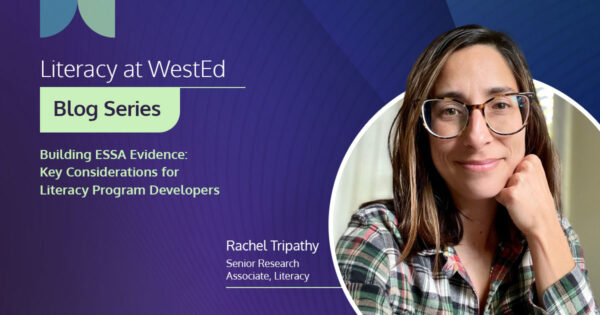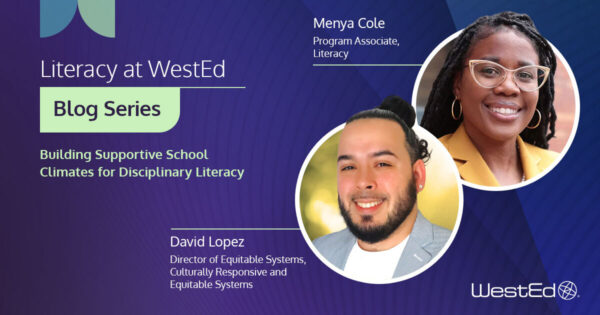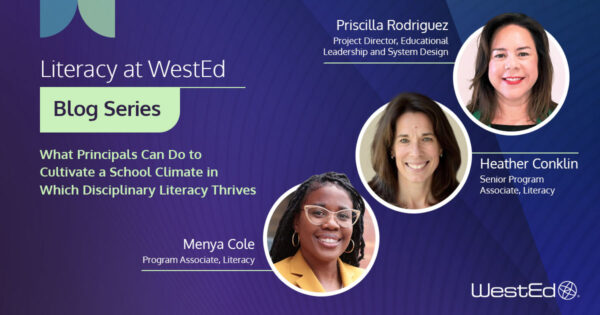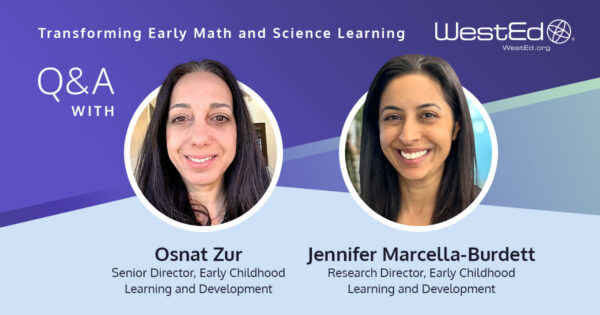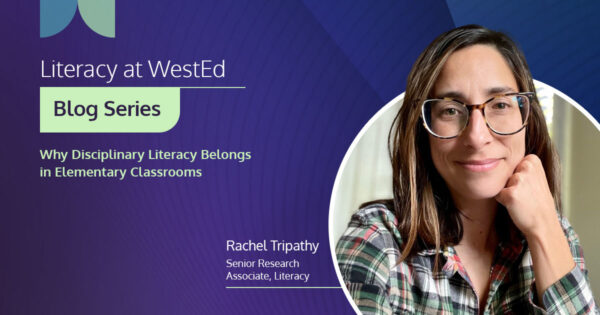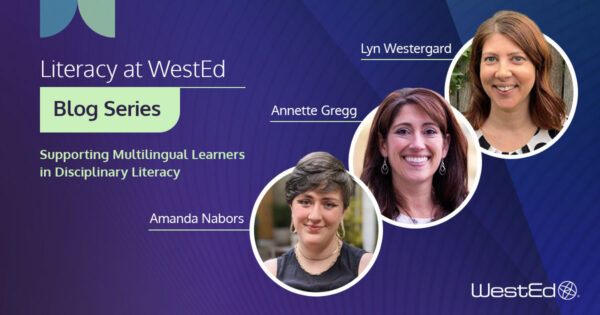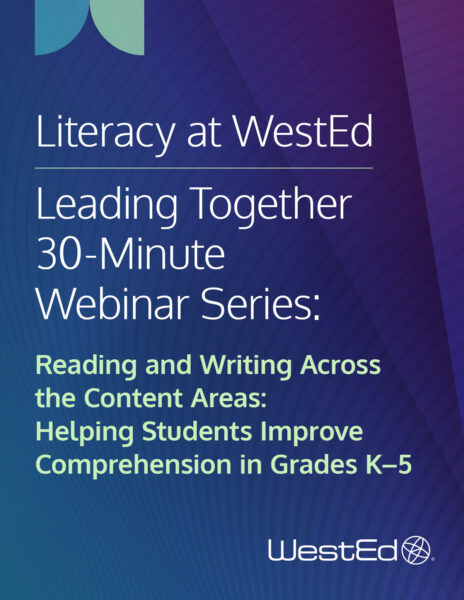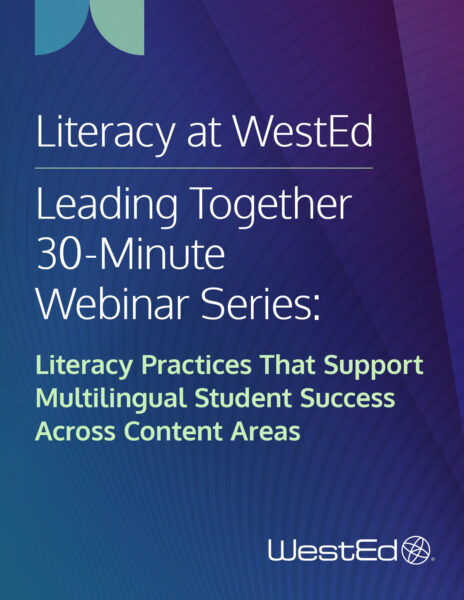
July 1, 2025
By Misty Sailors With Alana Newell and Nancy Moreno of Baylor College of Medicine
This blog series explores the concept of disciplinary literacy—the distinct ways of reading, writing, and communicating across academic fields such as science, history, math, and literature. Featuring actionable insights from WestEd thought leaders, the series looks at how integrating disciplinary literacy practices into elementary and secondary classrooms can support student success in school, in careers, and throughout their lives.
The landscape of science, technology, engineering, mathematics, and medicine (STEMM) education is rapidly evolving. As communities face unprecedented global challenges, the need for scientifically literate citizens and skilled STEMM professionals is especially critical. However, our educational systems often approach literacy and science as separate domains, which can limit opportunities to develop the specialized reading, writing, and communication skills that define scientific practice as a way of supporting students’ interest and entry into those fields.
On May 16, 2025, WestEd and Baylor College of Medicine (BCM) convened a diverse group of educators, researchers, and workforce interest holders for an institute on disciplinary literacy (those unique ways that expert practitioners in a field read, write, communicate, and think) in STEMM.
The central question driving this convening was both simple and profound: How can we better prepare students for futures in science and health by teaching them to read, write, and communicate as scientists and healthcare professionals do? The gathering surfaced many insights to help educators bridge the literacy–STEMM divide.
Navigating Uncertainty in the STEMM Landscape
Dr. Peter Hotez, a physician and scientist from Baylor College of Medicine, opened the institute with a sobering yet inspiring call to action: How might we meet the workforce demands under the current conditions in which we are living? Drawing from his recent publication, “Navigating Your US Bioscience Career Into the 2030s,” Hotez painted a picture of a world in which traditional career paths are being disrupted by massive global changes.
Key Insights
The New Reality Is Accelerating Change: Hotez outlined the “big shifts” reshaping the STEMM landscape: escalating global conflicts, environmental urbanization with over 40 new megacities (very large metropolitan areas with a population exceeding 10 million people) expected by 2030, emerging pandemic threats, and the rise of ideological movements that are skeptical of science. These disruptions represent a new normal that may persist for decades.
Participants immediately recognized the urgency of this message and highlighted the fundamental communication challenge that scientists face: how to communicate effectively with diverse audiences who may approach information in different ways.
STEMM Degrees as Life Skill Sets: Hotez argued that STEMM degrees are both about content acquisition as well as transferable competencies, including critical thinking, data analysis, research methodology, evidence-based reasoning, and communication. Perhaps most urgently, Hotez emphasized that scientists must actively engage in public discourse in the form of books, opinion articles, lectures, podcasts, national media, local media, and social platforms.
Call to Action
Hotez encouraged current and future STEMM education professionals to
- accept the long-term nature of current disruptions and be able to adapt;
- cultivate personal scientific brands through strategic communication and public engagement; and
- think strategically about their careers, asking fundamental questions about problems worth solving and definitions of success.
Rethinking Science Literacy for the Health-Informed Citizen
Dr. Nancy Moreno, Professor and Chair of the Huffington Department of Education, Innovation & Technology at Baylor College of Medicine, challenged fundamental assumptions about what constitutes science literacy in the 21st century.
Key Insights
Health Literacy as Scientific Literacy: One in three U.S. adults has limited health literacy—the ability to find, understand, and use accurate health information to make informed decisions. Health literacy requires the same cognitive skills as scientific literacy: evaluating evidence, understanding processes, and making informed decisions based on complex information.
The Missing Link in Education: Despite the clear connection between health and science literacy, health education is inconsistently taught across U.S. schools. Moreno shared research that reveals significant gaps: While 87 percent of high schools address topics like violence prevention, only 48 percent adequately cover chronic disease prevention, and many fundamental health topics receive even less attention.
Evidence for Integration: BCM’s STEMM education team, directed by Moreno, has demonstrated that teaching health concepts within science classes is achievable in the real world and produces significant learning gains. Their infectious disease lessons in elementary and high school science classes not only improved students’ understanding of viral biology and epidemiology but also increased interest in health-related careers. Similarly, nutrition and environmental health units taught through scientific inquiry methods showed measurable improvements in student knowledge. “Making a clear connection between science and health” emerged as a key theme in the breakout sessions.
Call to Action
Moreno advocated for
- systematic integration of health topics within science education;
- recognition of disciplinary literacy as essential to science learning;
- development of instructional materials that explicitly teach students how to read, write, and communicate as scientists; and
- teacher preparation programs that equip educators with both science content knowledge and disciplinary literacy pedagogical skills.
Making Disciplinary Literacy Practical in Classrooms
Dr. Misty Sailors, interim Literacy director at WestEd, and Dr. Alana Newell, Assistant Professor at Baylor College of Medicine shared their insights on how disciplinary literacy instruction can be effectively implemented in STEMM classrooms. They highlighted how scientific texts, even those adapted for younger audiences, present multiple layers of complexity. Because of this, students need explicit instruction in these disciplinary literacy skills.
Key Insights
The Four Dimensions of Text Complexity: Sailors and Newell provided a framework for understanding why scientific texts are so challenging for students:
- Linguistic Complexity: Dense noun phrases, technical vocabulary, nominalizations, and complex sentence structures
- Cognitive Load: High background knowledge requirements, nested concepts, and abstract thinking demands
- Textual Navigation: Integration across multiple modalities (text, visuals, data) and nonlinear information flow
- Epistemological Framing: Understanding scientific argumentation structures, passive voice conventions, and disciplinary norms
The speakers emphasized that disciplinary literacy instruction serves multiple purposes beyond improving comprehension. When students learn to read, write, and communicate as scientists, they develop science identity and sense of belonging—critical predictors of persistence in STEMM fields.
The ALL for Science Model: Newell presented their “Authentic Literacy and Language for Science” approach, which integrates three components:
- science-specific disciplinary literacy mini-lessons that explicitly teach reading strategies
- science inquiry circles where students apply these strategies to research questions
- guided science investigations that build conceptual knowledge through hands-on experiences
Results from their field tests show that students receiving integrated disciplinary literacy instruction not only outperformed peers in science content knowledge but also closed achievement gaps that typically disadvantage certain student populations.
Call to Action
The presenters called for
- widespread adoption of disciplinary literacy frameworks in STEMM teacher preparation and professional development at all grade levels;
- curriculum development that treats literacy as integral to, not separate from, science learning;
- research partnerships between literacy specialists and STEMM educators to further develop evidence-based practices; and
- policy advocacy to recognize the importance of subject-specific literacy in educational standards and assessments.
What’s Next: A Roadmap for Action
The institute concluded with a clear consensus: Preparing students for futures in STEMM requires fundamental changes in how we conceptualize and teach both literacy and science. The path forward involves multiple interconnected actions:
For Educators: Continue to integrate disciplinary literacy instruction into STEMM classes at all levels. Use the frameworks and strategies presented to help students develop the specialized reading, writing, and communication skills that define scientific practice.
For Curriculum Developers: Create instructional materials that treat literacy and science as inseparable. Move beyond generic reading strategies to develop discipline-specific approaches that honor the unique ways scientists construct and communicate knowledge.
For Policymakers: Advocate for educational standards and teacher preparation programs that recognize disciplinary literacy as essential to STEMM learning. Fund research and development initiatives that support this integration.
For Researchers: Continue investigating the connections between literacy instruction and STEMM learning outcomes, with particular attention to how these approaches can improve access and broaden participation in scientific fields.
For STEMM Professionals: Embrace the responsibility of communicating science effectively to diverse audiences. Develop the communication skills and strategic thinking necessary to engage in public discourse about scientific issues.
Staying Connected
The convening hosted by WestEd and the Baylor College of Medicine was the second convening; the first was hosted by Harvard’s Reach Every Reader program. We are looking forward to the third, which is planned for fall 2025 and will be hosted by Johns Hopkins University. It will be focused on the assessment of disciplinary literacy. We invite you to watch for announcements and invitations.
The Baylor College of Medicine hosts the National STEMM Network. Join the Network to access strategic planning guides that help schools develop or enhance STEMM programs.
Literacy at WestEd
WestEd works to enhance literacy and improve learning for all by providing high-quality, teacher-focused professional learning, research and evaluation, and technical assistance services. Throughout our work, we bring experienced, multidisciplinary perspectives to support educators in achieving accessible literacy outcomes for learners of all ages.
WestEd’s flagship reading program, Reading Apprenticeship, emphasizes the “invisible work” that expert readers do when reading texts in their field. Through classroom routines like metacognitive conversations and think-alouds, teachers make these tacit processes visible to students.
Our newly launched Writing Apprenticeship, modeled after the Reading Apprenticeship approach, helps students understand the disciplinary conventions and thinking processes that shape effective writing in different fields. Both Reading and Writing Apprenticeship position teachers as disciplinary literacy mentors who can model expert practices while gradually transferring responsibility to students.
Making Sense of SCIENCE (MSS) professional learning courses focus on supporting STEMM teachers in their understanding and utilization of metacognitive routines to cultivate students’ disciplinary literacy. During MSS courses, teachers model and reflect on these metacognitive routines through literacy investigations designed to help students more effectively engage in productive scientific discourse.
Learn more about Literacy at WestEd.
Misty Sailors is the interim Literacy director at WestEd. With over 30 years of experience in literacy education and research, Sailors is passionate about empowering educators and school and district leaders to provide high-quality educational opportunities for all students and about guiding educators in implementing evidence-based literacy instruction.
Register for Literacy Webinars
With WestEd expert speakers, these bite-sized learning opportunities are engaging and designed to deliver just-in-time support during your workday.
All webinars held from 12—12:30pm PT / 3—3:30 ET
Literacy Practices That Support Multilingual Student Success Across Content Areas, August 7, 2025
This session introduces four practical strategies to support multilingual students’ disciplinary literacy—translanguaging, explicit language instruction, assets-based pedagogy with high-quality materials, and disciplinary discourse—with special focus on applicability for newcomer students across a variety of classroom settings.
Ensuring Literacy Success Across the Disciplines for Students With Disabilities, September 9, 2025
Explore how to support students with disabilities in reading—including dyslexia—to succeed using strategies that draw upon disciplinary literacy approaches—the specialized ways of reading, writing, and thinking in subjects like science, history, and math.
Role of Instructional Coaches in Implementing Disciplinary Literacy Instruction, September 16, 2025
Discover how instructional coaches can play a central role in advancing disciplinary literacy instruction for all students across subject areas.
Stay tuned for additional webinars we will be hosting throughout 2025. Together, we will explore more ways to support your thriving communities!
